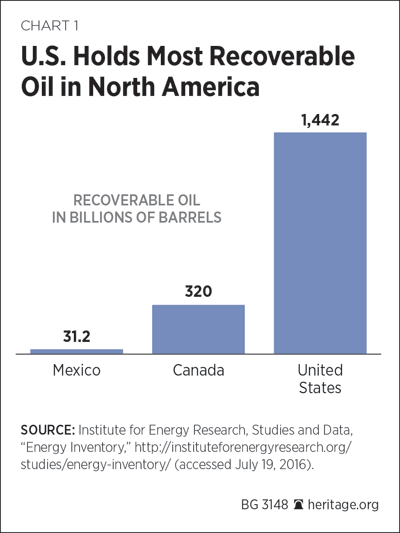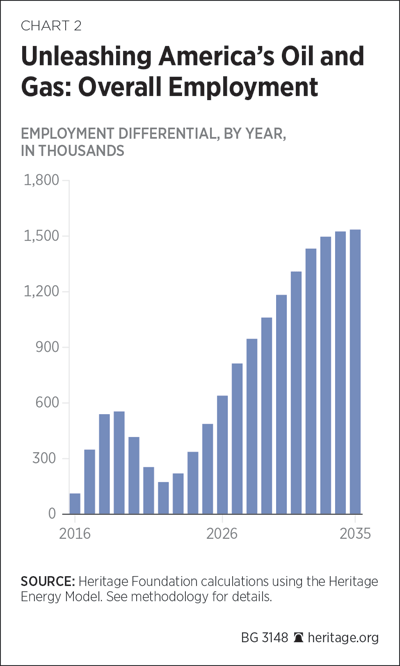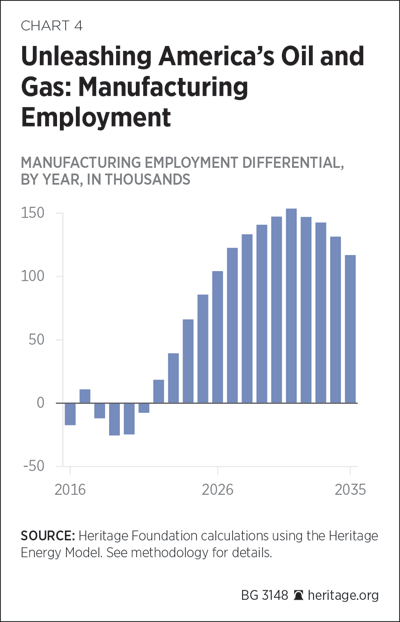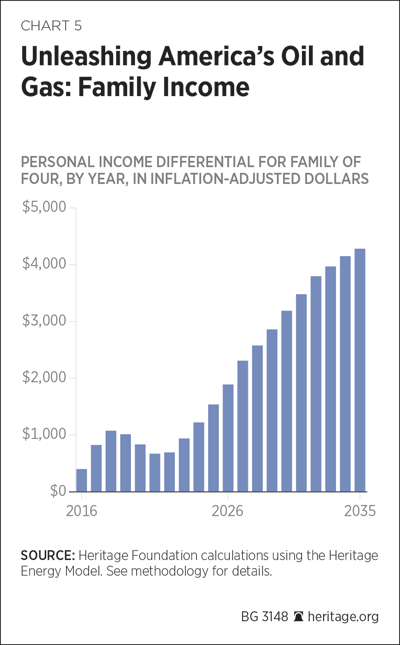In March 2012 President Barack Obama stated, “We can’t just drill our way to lower gas prices.”[1] He said the same thing earlier that year on the campaign trail.[2] He said it a lot.[3] Perhaps the line polled well, but it was not true. The U.S. did drill its way to lower gas prices over the past several years (for both natural gas and gasoline) and broke the back of the Organization of the Petroleum Exporting Countries (OPEC) in the process.[4]
The doubling of U.S. oil production between 2008 and 2015 is an amazing story of American ingenuity, persistence, and, of course, drilling. The story is made more amazing by the fact that federal energy policy actively hindered this energy renaissance as it was taking place. In the first few months of the Obama Administration, the Department of the Interior cancelled oil and gas lease sales.[5] In 2011, the Obama Department of the Interior blocked access to most of America’s offshore oil and gas reserves, placing a de facto moratorium on drilling.[6] The Environmental Protection Agency’s (EPA’s) hostility to the oil and gas industry was exemplified by regional administrator and Obama appointee Al Armendariz, who was captured on tape explaining that his policy was to “crucify” select oil and gas firms in order to terrify the others.[7]
In spite of the Administration’s policies, the energy sector thrived because of production on private and state-owned lands. As companies in the U.S. drilled their way to low petroleum prices, oil production from the federal estate was stagnant or declining.[8] So, it is reasonable to ask: What sort of energy powerhouse could the U.S. be with an energy policy that unleashes America’s total energy potential?
In its Annual Energy Outlook, the federal government’s Energy Information Administration (EIA) makes projections of energy production, consumption, and prices. The reference case assumes midpoint projections for energy resources and assumes that regulations follow their legislative timelines. As part of its sensitivity analysis, the EIA also produces two side cases where energy resources are assumed to be (a) 50 percent higher and (b) 50 percent lower than the reference case. Though these side cases are not intended to model policy changes, the High Resource Case offers a glimpse of what might be.
It should be noted that a 50 percent increase in resource availability is not a “pie-in-the-sky" fantasy. U.S. petroleum production in 2015 was about 50 percent higher than the projection the EIA made for 2015 in 2008.[9] Natural gas production in 2015 was about 40 percent higher than the EIA’s 2008 projection. The comparative pessimism on the part of the EIA was largely due to not fully appreciating the impacts of smart drilling technology and hydraulic fracturing (fracking) at that time.
Without comprehensive seismic mapping and exploration, an accurate estimate of the recoverable natural resources that are currently locked up on federal lands and the continental shelf is unlikely. However, the combination of a rational regulatory environment with open access would likely put a 50 percent increase within reach.
Using a clone of the EIA’s National Energy Modeling system, Heritage Foundation analysts looked at the impact of the High Resource Case on income and employment, as well as the impact on energy markets.
Heritage analysis shows that lifting needless and duplicative restrictions on energy production will increase employment by an average of 700,000 jobs through 2035. Along with the jobs comes $3.7 trillion in additional gross domestic product (GDP) that translates to an additional $40,000 of income per family of four by 2035.
Abundant Energy Reserves on U.S. Soil
Many believe that America has only a small fraction of the world’s oil resources and that supplies will soon be exhausted. In fact, America has an abundance of energy resources. Though not all reserves are recoverable with today’s technology, recent estimates project that the United States has over five times as much oil as Saudi Arabia. In fact, when American, Canadian, and Mexican reserves are combined, North American oil reserves total nearly 1.8 trillion barrels of recoverable oil.
To put this figure in perspective, the single continent of North America currently has more recoverable oil than the entire world has used since Edwin Drake drilled the first commercial oil well in Titusville, Pennsylvania, in the mid-1800s. Much of the oil in the United States is concentrated in the Bakken Formation in Montana and North Dakota, but also occurs in many other areas of the country including Alaska, California, Oklahoma, and Texas. The resources in North America could continue to meet current energy demands across the country for well over the next 200 years.
These estimates are also always in flux. For example, in 1980, the United States was thought to have roughly 30 billion barrels of oil reserves. Over the subsequent 30 years, the U.S. produced nearly 80 billion barrels.[10]
Much of this oil, known as tight oil or shale oil had not been accessible with conventional extraction techniques. Improvements in technologies, primarily horizontal drilling and fracking, now enable producers to extract the oil and gas from these tight formations.
Furthermore, technological advancements have significantly increased the amount of recoverable natural gas in the United States. The estimated 2,200 trillion cubic feet of recoverable natural gas in the U.S. is equivalent to 84 years of consumption at current rates.[11]
Companies have safely used such processes for decades in the U.S. to extract oil and gas from hundreds of wells across the country. In fact, the technology has improved so dramatically that companies are re-fracking wells to extract even more oil and gas from previously drilled wells.
The Economic Effects of Freeing Up America’s Resources
Fracking and horizontal drilling have been critically important technologies in the extraction of the vast amount of recoverable oil and gas in various parts of the country and the revitalization of America’s energy sector.[12] Drilling and extraction create jobs, but there are often tremendous job opportunities for engineers, geologists, mathematicians, truck drivers, welders, and others as well. There are also increased needs for associated manufacturing as well as demand for repair shops, menders, hardware stores, restaurants, hotels, and laundromats among many others. Natural gas and butane, ethane, and propane removed from natural gas provide feedstock for fertilizers, chemicals, and pharmaceuticals. The shale gas boom resulted in more than $100 billion in new chemical manufacturing investment.[13]
Unfortunately, however, anti-energy politicians and government bureaucrats have instituted a variety of policies and regulations that have rendered at least 60 percent of recoverable oil inaccessible.[14] Many of these regulations are based on concerns regarding the safety and potential contamination of water. However, a multi-year study recently conducted by the EPA found that fracking has not significantly or systemically impacted drinking water.[15] Proper enforcement of property rights, in conjunction with appropriate regulations implemented by state and local governments, not only enable the extraction of potentially valuable resources, but also have remarkable ability to protect the environment.[16]
We used the Heritage Energy Model (HEM), a clone of the EIA’s National Energy Model (NEM), to quantify the impact of freeing up the energy markets by lifting the crude export ban as well as increasing the availability of domestic petroleum and natural gas. The HEM was used to compare current policy (the reference case) to a policy with broader access to energy resources (the alternative case). To model the impact of lifting burdensome regulations on the oil and gas industry, several assumptions were changed. Under this policy alternative, recoverable shale oil and shale gas and their variants are 50 percent higher, and well spacing is 50 percent lower than the reference case. There are a few less impactful assumptions, which are discussed in the appendix.
These results are quite striking. By 2035, the economy would experience an average positive employment differential of over 700,000 jobs with a peak employment differential of 1.5 million jobs. Chart 2 illustrates the impact of lifting these regulations on overall employment, across the American economy.
Chart 3 shows some of the industries that would see significant job gains as a result of a federal pro-energy policy.
These percentage differentials are quite substantial with respect to the overall economy, which has an average differential of 0.5 percent annually between the baseline and alternative scenario. These results are not surprising, as certain components of the economy will benefit tremendously not only from the reduced energy prices but also from the increased demand as the quest for cheaper and more affordable energy continues.
Although manufacturing employment declines in certain years, that change is simply a result of the American free market at its best. As a market expands, new jobs replace old jobs and the economy grows. Chart 4 provides the impact on manufacturing employment.
These economic gains arise for a variety of reasons. First, there is an increase in job creation directly associated with producing shale oil and gas not otherwise under current policy. In addition, the resulting energy—used all across the economy—becomes less expensive. Cheaper energy lowers the cost of doing business, making American companies more competitive and enabling them to invest and expand.
Americans stand to benefit from the increased economic activity. Chart 5 depicts this growth in terms of personal income for a family of four. As Chart 5 illustrates, annual income rises by thousands of dollars per family as a result of improved energy policy. In particular, by 2035, the average American family would enjoy a total gain of more than $40,000 in personal income. In terms of aggregate GDP, these gains translate into almost $3.7 trillion of increased aggregate GDP through 2035.
Finally, there is a drop in household electricity expenditures. This decline is due to the more efficient and less expensive forms of energy dominating the market and becoming a commonplace form of electricity generation for American households. (See Chart 6.)
How Congress and the Next Administration Should Lead
The economic potential of unleashing America’s energy resources is tremendous. To achieve these gains, Congress and the next Administration should:
- Open access to energy exploration of federal waters and lands. The next Administration should open all federal waters and federal lands that are not part of the national park system or congressionally designated areas to exploration and production for all of America’s natural resources. Congress should require the Department of the Interior to conduct lease sales if a commercial interest exists.
- Prevent and reverse federal regulations on fracking. The federal government should allow states to regulate fracking without federal interference. The Department of the Interior has issued federal regulations on fracking on federal and Indian lands. Recently, the EPA released methane regulations for oil and gas activities. But federal regulations duplicate existing state regulation of fracking since companies must obtain state permits for all wells, including federal wells, and must comply with all state regulations. Citizens working with state and local bureaucrats have a significantly better sense about their environment than Washington bureaucrats who may be thousands of miles away. Local government officials should therefore have the prerogative of instituting regulations regarding fracturing.
- Allow states to manage energy development. Permitting fracking on federally owned land will result in even more oil and gas extraction and create jobs in areas that would otherwise not see such economic growth. Congress should explore ways to sell federal lands to states and private individuals who are in a better position to reap the benefits from energy production while protecting the environment. Short of that, however, Congress should grant authority to states for environmental review and permitting of energy projects on federal lands within their borders.
- Avoid useless global-warming taxes and regulations. Any carbon-dioxide tax or carbon-capture-related policies will discourage the use of conventional fuels, including shale oil and gas. These policies will drive up energy costs for everyone and destroy jobs, while providing a negligible impact on global temperatures.[17] Congress and the next Administration should prevent any agency from regulating greenhouse-gas emissions without compelling and scientifically unambiguous evidence of need and regulatory effectiveness.
- Expand free trade for energy sources. Owners of energy resources should be allowed to seek the best options for selling their products and assets. In a similar vein, consumers should be free to choose the supplier that offers the best combination of price, quality, and convenience. Freedom to trade is one of the great strengths of the American economy. The federal government should treat energy sources like all other goods that companies trade regularly, and lift restrictions on energy exports and imports.
Conclusion
Often taken for granted, energy is an integral component of human life all across the world. By tapping many of its uncovered resources, America has the potential to be the world’s largest producer of energy. With the right policies in place, tapping this energy can help create a vibrant and prosperous economy for decades to come.
—Kevin D. Dayaratna, PhD, is Senior Statistician and Research Programmer in the Center for Data Analysis, of the Institute for Economic Freedom and Opportunity, at The Heritage Foundation. David W. Kreutzer, PhD, is Senior Research Fellow for Energy Economics and Climate Change in the Center for Data Analysis. Nicolas D. Loris is Herbert and Joyce Morgan Fellow in Energy and Environmental Policy in the Thomas A. Roe Institute for Economic Policy Studies, of the Institute for Economic Freedom and Opportunity.
Appendix: Methodology
The Heritage Energy Model (HEM)
The analysis in this Backgrounder uses the Heritage Energy Model (HEM), a derivative of the National Energy Model System 2015 Full Release (NEMS).[18] NEMS is used by the EIA in the Department of Energy as well as by various nongovernmental organizations for a variety of purposes, including forecasting the effects of energy policy changes on a plethora of leading economic indicators. The methodologies, assumptions, conclusions, and opinions in this Backgrounder are entirely the work of statisticians and economists in the Center for Data Analysis (CDA) at The Heritage Foundation, and have not been endorsed by, and do not necessarily reflect the views of, the developers of NEMS.
HEM is based on well-established economic theory as well as historical data, and contains a variety of modules that interact with each other for long-term forecasting. In particular, HEM focuses on the interactions among (1) the supply, conversion, and demand of energy in its various forms; (2) American energy and the overall American economy; (3) the American energy market and the world petroleum market; and (4) current production and consumption decisions as well as expectations about the future.[19] These 12 modules are:
- Macroeconomic Activity Module,[20]
- Transportation Demand Module,
- Residential Demand Module,
- Industrial Demand Module,
- Commercial Demand Module,
- Coal Market Module,
- Electricity Market Module,
- Liquid Fuels Market Module
- Oil and Gas Supply Module,
- Renewable Fuels Module,
- International Energy Activity Module, and
- Natural Gas Transmission and Distribution Module.
HEM is identical to the EIA’s NEMS with the exception of the Commercial Demand Module. The Commercial Demand Module makes projections regarding commercial floor-space data of pertinent commercial buildings. Other than HEM not having this module, HEM is identical to NEMS.
Overarching the 12 modules is the Integrating Module, which consistently cycles, iteratively executing and allowing these various modules to interact with each other. Unknown variables that are related, such as a component of a particular module, are grouped together, and a pertinent subsystem of equations and inequalities corresponding to each group is solved via a variety of commonly used numerical analytic techniques, using approximate values for the other unknowns. Once a group’s values are computed, the next group is solved similarly, and the process iterates. Convergence checks are performed for each price and quantity statistic to determine whether subsequent changes in that particular statistic fall within a given tolerance. After all group values for the current cycle are determined, the next cycle begins.[21] HEM provides a number of diagnostic measures, based on differences between cycles, to indicate whether a stable solution has been achieved.
We used HEM to analyze the impact of making hydraulic fracturing more feasible by increasing the availability of petroleum in North America. In particular, we ran two of the same simulations that the EIA used in “Effects of Removing Restrictions on U.S. Crude Oil Exports,” in comparing the impact of lifting the export ban to the impact of lifting the export ban coupled with greater availability of shale oil, shale gas, and its variants in North America.[22]










